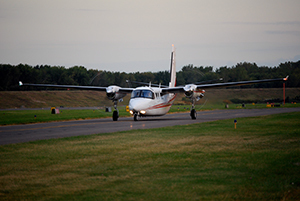By William Shinew
First published in Flight Levels Online, Spring 2013 issue

One of the benefits of being a Twin Commander instructor pilot at SimCom is that I often pick up information from customers based on their own unique experiences. I am then able to pass that information on to others so that all may benefit from these collective experiences. As an example, over the last several months I have heard of several instances of fuel caps coming off in flight due to improper securement. I’d like to discuss this, and examine how we might learn from the experiences of other Twin Commander pilots regarding this important item.
Those of us who have experience in other turbine twins such as King Airs, Cheyennes, Conquests, Citations, etc. never give checking fuel caps a second thought, because the caps are where we can easily see and reach them. Checking fuel cap security has always been a normal and convenient part of a preflight walk-around on those airplanes.
Checking fuel caps should also be a normal part of a preflight walk-around on Twin Commanders. However, unless you are Kareem Abdul Jabbar, checking fuel caps on a Twin Commander for proper securement requires the use of a stepladder. This inconvenience often leads us to simply trust that the line guy did his job properly after refueling our aircraft. Unfortunately, this is not always the case.
Several months ago it was my privilege to provide initial Twin Commander training to a motivated young pilot who had just been hired to operate a 690B under Part 91. On his second trip after refueling at his destination and in an effort to please his new boss, he expedited the preflight inspection and boarding process. On this particular trip he had a second experienced twin-turbine pilot along as copilot. Each pilot assumed the other pilot had checked the fuel caps. In fact, neither of them had done so.
Less than an hour into the flight back to their home base, both pilots noticed the fuel gauge was not telling the same story as the fuel totalizer. The fuel gauge was dropping rapidly. Discussions in the cockpit centered on either making an immediate precautionary landing or continuing on under the assumption that the fuel gauge was faulty. The young captain elected to continue towards home since he knew that he had ordered enough fuel to easily make the trip with adequate reserves.
Within a few minutes of that decision, the low fuel light on the annunciator panel illuminated. A minute or so after that, the right engine spooled down, followed shortly by the left engine. Now the answer was painfully clear. They were out of fuel at cruise altitude at night. Fortunately, it was VMC. A quick call to ATC got them a vector to the nearest suitable airport with lighted runways. This young pilot was now faced with declaring his first emergency and making a dead-stick landing at night into an uncontrolled airport.
All my training customers get to practice at least one dual flame-out dead-stick landing in the simulator during their training in the simulator. The good news is that in the case of this young captain, he did exactly as he was taught in the simulator. He spiraled down over the airport until he was approximately 4,000 feet AGL. He chose his intended runway and made what turned out to be a relatively uneventful landing considering the circumstances.
I was delighted to learn he was able to dead-stick that Twin Commander in for a safe landing with zero injuries or damage. The lesson here is very clear. It would have been infinitely better to have checked the fuel caps for proper securement. This captain now faithfully checks his fuel caps before every flight.
I was telling this story to another customer who was in for recurrent training, and he confessed that he had once landed without a fuel cap. In his case the flapper valve in the filler neck functioned properly and he had no noticeable loss of fuel. In the young captain’s case detailed above, the flapper valve for the inboard tanks obviously had failed for one reason or another.
Like one of my flight instructors told me almost 40 years ago, “Your superior judgment is supposed to keep you from having to rely on your superior flying skills to get you out of a mess that never should have happened.” Until next time, fly safe and check those filler caps!
